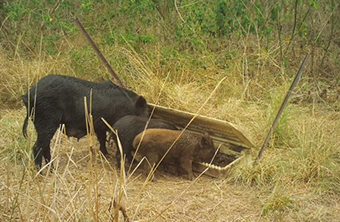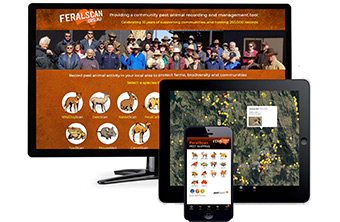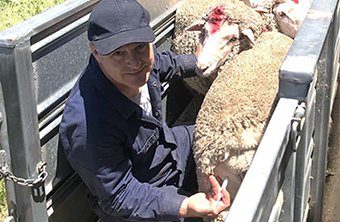Wild dog control benefits native wildlife
Wild dog and fox control programs not only support the livelihoods and emotional wellbeing of livestock farmers, they also help conservation efforts for endangered native wildlife.
Wild dog and fox control programs not only support the livelihoods and emotional wellbeing of livestock farmers, they also help conservation efforts for endangered native wildlife.
Woolgrowers primarily undertake wild dog and fox control programs to minimise attacks on their flocks, thereby improving the welfare of their animals and reducing the financial and emotional impact on themselves and their families. However, control programs also have a positive environmental impact, reducing predation on Australia’s native animal species.
When it comes to food, wild dogs are not fussy diners, they prey on 229 native animals including mammals, birds and reptiles of all sizes from insects to water buffalo. However, they prefer to eat small and medium-sized mammals when available, including native mice, dunnarts, bandicoots and wallabies.
In addition to direct predation, wild dogs carry hydatid worms (Echinococcus granulosis), a zoonotic disease (transmittable to humans) that has severe implications for native species, particularly macropods such as the rare bridled nailtail wallaby thought to be extinct for most of the 20th century.
Wild dogs have been directly implicated in the rapid decline of some of Australia’s most iconic species including 14 native mammals, reptiles and birds listed under the national Environment Protection and Biodiversity Conservation Act 1999.
These 14 threatened species include 10 mammals: marsupial moles, smoky mouse, golden bandicoot, northern quoll, greater bilby, long-footed potoroo, bridled nailtail wallaby, Proserpine rock-wallaby, koala and northern hairy-nosed wombat; three birds: black-breasted button-quail, malleefowl and southern cassowary; and marine turtles.
A four-year study by Australia’s leading koala conservation researchers identifies wild dogs as “by far the most significant threat to the species” at its study site in south-east Queensland.
Woolgrowers and other landholders undertaking wild dog and fox control programs are therefore rightly proud that they are not only protecting their flocks, but are also helping native wildlife to survive and thrive.
1080 IS TARGET SPECIFIC TO DOGS AND FOXES
Sodium fluoroacetate (1080) is the major control tool used to manage the impacts of wild dogs and foxes on Australia’s livestock industry (and to protect threatened native fauna). It can be very effective when land managers use it as part of strategic, broadscale, coordinated control programs supported by other control methods such as trapping, fencing, shooting and guardian animals.
1080 is a naturally-occurring toxin found in more than 30 species of Australian native plants. It is an environmentally responsible option for invasive species control because Australian fauna are highly tolerant to it. Wild dogs on the other hand are highly susceptible to 1080.
The target specificity of 1080 to wild dogs is further enhanced by using meat-based baits, placing baits carefully and strategically, burying or hiding baits, tying them to known locations, and regulating minimum size of the baits used. State and territory regulations also manage the use and availability of 1080 baits to lower the risks to non-target species.
1080 is environmentally safe as it biodegrades quickly and is broken-down into harmless compounds by microorganisms and bacteria when exposed to soil and water.
More information:
www.pestsmart.org.au/toolkit-resource/wild-dog-risks-to-threatened-wildlife
www.wilddogplan.org.au/biodiversity-welfare
QUOLL SIGHTINGS ON THE RISE
A young spotted-tailed quoll. PHOTO: CraigRJD
Scientific evidence and leading ecologists have long supported the view that aerial baiting is good for quolls. A 2008 study found that you are 100 times more likely to find spotted-tailed quolls in areas with long-term aerial and ground baiting for wild dogs and foxes.
Baiting helps protect quolls by reducing predation from introduced predators such as wild dogs, foxes and cats, while reducing competition for quolls’ food sources, giving fledgling populations a fighting chance to rebuild.
In North-East NSW’s rugged terrain, where successful aerial baiting campaigns have been held for several years, there are encouraging reports from producers of quoll sightings – in some areas these are the first for generations.
AWI’s wild dog coordinator for North East NSW, Dave Worsley, is a second-generation cattle and sheep producer on the Northern Tablelands. He is excited to find quolls returning to his farm and hearing similar reports from his neighbours.
“My family has been there since 1968 and we’ve never had quolls until now,” he said. “I’ve even seen quolls on the Severn River and I spent a lot of time as a child roaming that river, fishing in the dark, and never once saw a quoll.
“I’ve also heard Pindari Dam campgrounds have recorded quoll sightings, it’s really exciting, and the other day we had a laugh. A neighbour of mine was having trouble with possums, he thought, turning on his radio in his caravan at night. I lent him a camera trap and it turned out to be a family of quolls.”
More information: www.wilddogplan.org.au/research
This article appeared in the March 2021 edition of AWI’s Beyond the Bale magazine. Reproduction of the article is encouraged, however prior permission must be obtained from the Editor.















